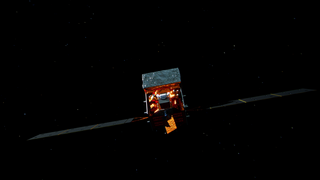360 Degrees of GLAST
GLAST will carry two instruments: the Large Area Telescope (LAT) and the GLAST Burst Monitor (GBM). The LAT is GLAST's primary instrument and consists of four components: the Tracker, the Calorimeter, the Anticoincidence Detector (ACD), and the Data Acquisition System (DAQ). These instrument components working together will detect gamma rays by using Einstein's famous equation (E=mc(squared) in a technique known as pair production. The GLAST Burst Monitor is a complementary instrument and consists of low-energy detectors, high-energy detectors, and data processing unit. The GBM can see all directions at once, except for the area where Earth blocks its view. When the GBM detects a bright gamma-ray burst, it immediately sends a signal to the LAT to observe that area of the sky.
Animated fly-around of the Fermi spacecraft against a depiction of the gamma-ray sky. This is a 4k upres of the original frames.
Credit: NASA’s Goddard Space Flight Center/CI Lab
This beauty shot provides a 360-degree view of the spacecraft without a simulated gamma ray sky.
This beauty shot provides a 360-degree view of the spacecraft with a simulated gamma ray sky.
For More Information
Credits
Please give credit for this item to:
NASA/Goddard Space Flight Center Conceptual Image Lab
-
Animator
- Chris Meaney (HTSI)
-
Scientist
- Steven Ritz (NASA/GSFC)
Missions
This page is related to the following missions:Series
This page can be found in the following series:Datasets used
-
[Fermi: LAT]
ID: 216Fermi Gamma-ray Large Area Space Telescope (GLAST) Large Area Telescope (LAT)
This dataset can be found at: http://fermi.gsfc.nasa.gov
See all pages that use this dataset -
[Fermi]
ID: 687
Note: While we identify the data sets used on this page, we do not store any further details, nor the data sets themselves on our site.
Release date
This page was originally published on Friday, September 14, 2007.
This page was last updated on Wednesday, May 3, 2023 at 1:55 PM EDT.
